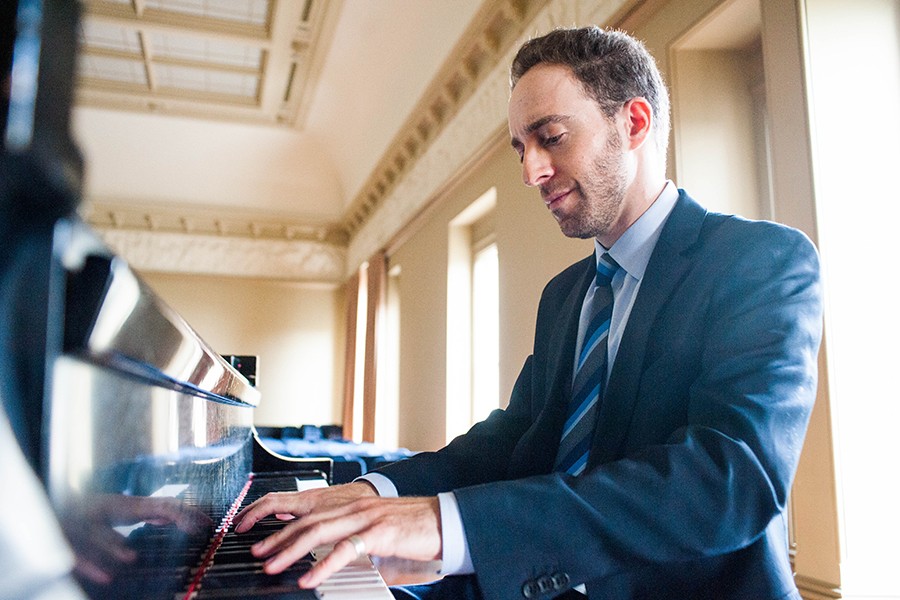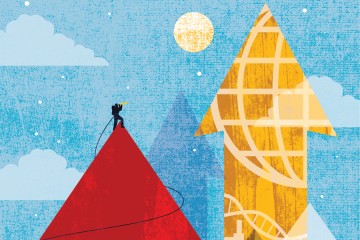On the morning April 19, 2015, Peabody Institute faculty composer Judah Adashi was getting ready to head to Washington, D.C. for the world premiere of his work Rise, a collaboration with poet and playwright Tameka Cage Conley.
For both Adashi and Cage Conley, Rise was a meditation on 50 years of civil rights struggle in America, a reflection on how much and how little changed in the half century between the Bloody Sunday march on the Edmund Pettus Bridge in Selma, Alabama, in 1965 and the birth of the Black Lives Matter movement. The choral piece was commissioned by the Cantate Chamber Singers and included Howard University's Afro Blue jazz vocal group.
That morning Freddie Gray, a 25-year-old West Baltimore man, died as a result of injuries sustained while in police custody. Though the full Baltimore Sun report on Gray's death wouldn't be updated for the last time until around 11 p.m., news of his death began circulating through Twitter that morning. Baltimore, and its understanding of and vision of itself, hasn't been the same since.
One year to the day after Gray's death, Adashi brings Rise to Baltimore for the first time, only the second full performance of the piece. RiseBmore2016, which will include a panel discussion and musical performance, will take place Tuesday at Mount Vernon Place United Methodist Church. Local activist and actress Sonja Sohn, poet Tariq Touré, writer and Johns Hopkins alumnus D. Watkins, and former NFL linebacker turned artist Aaron Maybin will talk about their work prior to the premiere of Adashi's new piece, "The Beauty of the Protest"—performed by cellist and Peabody alumna Lavena Johanson—and Rise featuring Afro Blue, the Howard University Choir, Occasional Symphony, and the Peabody Community Chorus. The event is free and sponsored by the Peabody Institute.
Adashi will also discuss Rise, art, and activism at a pair of upcoming events—at Red Emma's on Sunday at 7:30 p.m. with Cage Conley; and at the Impact Hub Baltimore April 27, at 6 p.m., and event that includes Johanson performing "The Beauty of the Protest" and an exhibition of work by photographer Devin Allen and of a few of his mentees from Kids Safe Zone, the West Baltimore nonprofit that provides a safe space for kids ages 5 to 17.
The Hub caught up with Adashi to talk about revisiting Rise, countering mainstream Baltimore narratives, and the role music can play in political protest.
I know Rise was was a direct response to many things going on around the country, and that it was a commission, but it debuted on the same day that Freddie Gray died, a day when all of the issues it addresses came home in a really devastating way. Has your relationship to the piece changed at all, and if yes, how so?
We're just getting the rehearsal process under way, so I haven't had that experience yet of hearing it again, although we have performed a movement here and there. So in part I don't know yet what that's going to feel like.
I do know that from the moment that confluence started to materialize that day—that morning I was looking on Twitter and there were vague reports that someone had died in police custody in Baltimore. I didn't know the backstory yet, I don't know how many of us did. And then everything unfolded that week.
I wanted to bring the piece to Baltimore after its premiere in D.C., but it suddenly took on this urgency—I think I wrote in the program notes that this piece traces America's civil rights journey from Selma to Ferguson and beyond. And then "beyond" presented itself in my hometown. This was no surprise or anything new about Baltimore, but to have it thrust into the foreground, in the same way that Ferguson was thrust into the foreground ... . One place after another, events like this were tumbling into the mainstream narrative, mainly because of videophones. Coming home from D.C. that day, and then the rest of the week, having this astonishing phalanx of police presence—the juxtapositions that we tried to evoke in the piece, of, let's say John Lewis being beaten on Edmund Pettus Bridge in Selma in 1965 and juxtaposing that with very similar, if not identical, events happening right now. It was eerie to see that unfold in the streets before your eyes—and, in my case, from a perfectly safe and privileged standpoint.
I ask because you're returning to it a year later, on the same date, in Baltimore. Why? What did you want to do with this program?
I wanted to lead with the artists and activists that I admire in this city, so D. Watkins, Tariq Touré, Sonja Sohn—who kind of never let go of this city after The Wire—and Aaron Maybin, a former NFL player from Baltimore who has become a full-time visual artist. I wanted the event not to be about the piece. Of course, it's a piece of music I wrote and I'm happy to be presenting it, but they need to lead off the event because I don't know anything about growing up black in Baltimore, and I wanted that to be the voice that introduces this. So they'll lead off with a conversation about their work and how what they do is their way of responding to and engaging with their city. I just really appreciate these artists who embrace the totality of the human experience and the totality of the Baltimore experience.
Can you tell me a bit about the new piece that's also on the program, "The Beauty of the Protest"?
It's a short piece I wrote inspired by Devin Allen's photos. The title comes from something he said. He was interviewed in The New York Times about his work and he articulated the ways in which he was offering a counter narrative, I think, to the looped CVS footage. And he said, "I wanted people to see the beauty of the protest." And that really spoke to me—his photos document the good, bad, and ugly, and I appreciate that about him, but that idea that protest is a beautiful and necessary thing—that was hardly focused on in the national media. I felt he captured that so well, and it made me really want to do something in music that reflected that sensibility, just the idea of celebrating what is beautiful in the act of protest. We could all have these hours-long conversations about what happened here last spring, and I can tell you I get very tired of hearing "recent events" and "events of last spring" and especially "the unrest." It sounds like the title of a bad horror flick. I'm comfortable with Baltimore Uprising. I think we need to embrace the beauty and power of this. Devin does that and I wanted to try to reflect that.
It's a solo cello piece, the cellist also sings. The cellist in this case is my fiancée. She can sing and play cello, which I wanted. I was inspired by protest chants, in a way, and that's what I wanted to draw on, with the lyricism of the cello as the beauty part. Cello has the grain of the voice in it and, to me, the combination of the singing cello and the singing cellist allows one to evoke this beautiful mobilization.
I just wanted a chance to do something that recognizes this day. That's something that stayed with me. I was obviously struck by the coincidence of the premiere—it means nothing to anyone but me. And I think ever since that point, and I'm not the first to say this, it's so easy to forget the people who are the story at the heart of this. We tune into these stories so late—many have pointed out the fact that someone like Freddie Gray was being killed for years. But one way or another this permeated a wider consciousness in our city and beyond, and I think one way to honor that is to recognize that there may be a movement but there's also a human story—Freddie Gray and Tyrone West before him, and sometimes that move from person to hashtag is too quick. I think we don't force ourselves collectively to sit with that, and I think music is a good way to do that.
Is that the role you see music being able to play in activism and protest?
I think I've become a big proponent of—and I've picked this up from generations of people I admire—seeing music as a great vehicle for bearing witness. And in conjunction with poetry, it can be a vehicle to do that. Just in terms of time, to say, OK, we're going to sit here for 40 minutes and we're going to listen to a lot of things. Yes, great singing and great playing, but we're going to listen to a litany of names, of black men who have been killed by police officers. We're going to listen to that. We're going to listen to something more joyous, celebrating the election of the first black president. We're going to listen to something more joyous marking MLK shedding a tear when he heard Lyndon Johnson speak directly about voting rights and civil rights to Congress. That juxtaposition is what we live with, and I think music is the way you manipulate sound and time and, by extension, you get a chance to suspend this experience, to hold this meditation out for however long you want to.
There are portions of Rise that are very incantatory and repetitive, and that was a natural outgrowth of my desire to do this. We have to sit with this. I had to sit with this when writing this music. My collaborator had to sit with it—she had to sit with the thought that her African-American son was born very close to when Michael Brown was left to die in the streets. This was not an easy writing experience for her. It was important and cathartic but it was not easy. I think we all have to sit with this and our role in it, our complicity in this. And music offers a multifaceted way of doing that, a provocative way of doing that, sometimes a joyous way of doing that. It really makes you confront some things. This is a way for us to process something and meditate on something together.
Posted in Arts+Culture, Voices+Opinion
Tagged music, civil rights, judah adashi









